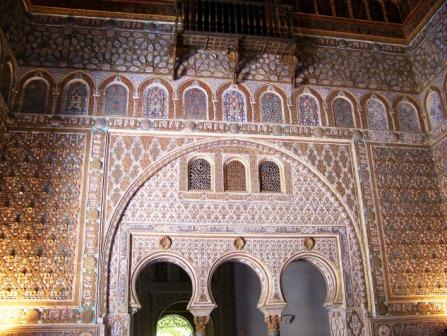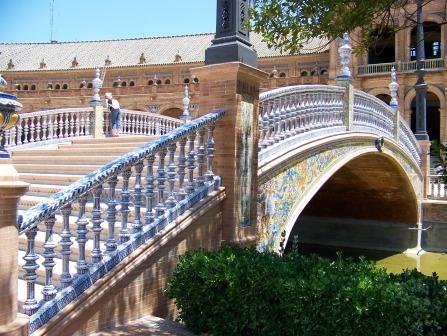Sevilla
Sevilla--known in English as Seville--has been inhabited since the Roman era, well situated fifty miles inland for protection from invaders and from inclement weather but on the wide Guadalquivir River with easy access to the Atlantic Ocean. It was the capital of the Moors during the Almohad era. The Almohads were nomads from North Africa, but in 1170 they conquered southern Spain and transferred their capital there. In 1248 the town was conquered by the Christian Spanish from the north.
One of the glories of Seville is its spendid Gothic cathedral, together with its bell tower, called La Giralda.
In fact, though, all but the uppermost part of the bell tower and much of the foundations for the cathedral come from the Almohad era, and formed the main minaret and mosque for the Muslim city. That can be seen more clearly from close up, and especially in the walled courtyard next to the church. That sort of courtyard is a typical feature of mosques but not typical for churches except here in southern Spain.

At the center of
the cathedral courtyard is a fountain for ritual ablutions that Muslims are
required to do before entering a mosque.
The courtyard--planted
with orange trees--is clearly visible from the top of the bell tower.
The medieval Gothic
look of the cathedral itself is also evident. Unlike Córdoba, the great
mosque at Seville
was mostly demolished and replaced by this structure that was begun in 1401
and took a century to complete.
Beside the cathedral is the irregular main square of Sevilla, with the royal palace on the upper left. The square building with a central courtyard on the middle right is the Archives of the Indies, where are kept the historical records of Spain's vast overseas empire--that once included lands as far flung as Mexico and central America, Cuba and much of the Caribbean, most of south America from Columbia and Peru to Chile and Argentina, and the Philippines. The last remnants of that vast empire were lost only in the twentieth century, when Spain relinquished Morocco in 1956 and the Spanish Sahara in 1976, although Spain still holds a few port towns on the Moroccan coast. (As the one who started it all, Christopher Columbus is buried in the cathedral.)
From the bell tower
can also be seen Seville's bullfighting arena--a sport still going strong
and even televised fairly often.
The interior of
the cathedral.
Behind the high
altar is the Retablo, a common feature in Spanish churches,
with hundreds of niches holding statues of the saints. This one is entirely
covered in gold leaf.
The other great glory of Seville is the royal palace, called the Real Alcázar.
It was begun by the Moorish Almohad rulers and continued under medieval kings of Castile and early modern kings of Spain. It is sometimes difficult to distinguish the different parts of the palace: in the fifteenth century Spanish architects were so impressed by the artistry of the Moorish style that they began to copy it in new buildings, in a style called Mudéjar. The upper floor of the palace is still used as a royal residence.
The entrance courtyard.
Modern windows
behind medieval arches.

Other decorative
details in the courtyard.

The Patio of the
Maidens shows the interesting blend of styles:
the lower floor is Moorish Almohad and the upper floor is Renaissance.
The medieval reflecting pools had been paved over centuries ago and were only
recently rediscovered.

The opulence of
the interior rooms is awesome.



Perhaps
most impressive are all of the elaborate details, including painted plaster
carvings covering all surfaces, some with gold leaf.

The ceilings are
either intricate inlaid wood or domes of tile and painted plaster.
Tilework often
covers the lower half of walls--and the designs were created by cutting tiles
to precise shapes.

The tilework is
a fascinating mix of styles, too--with Moorish designs, as on the left, and
Renaissance designs, as on the right.
As beautiful as the palace itself is, the gardens that open out from it are equally remarkable.




A few remnants
of the Moorish era survive elsewhere. One is the
Tower of Gold (below), built in 1220 alongside the river as a defensive lookout.
This church has
incorporated the walls of a former mosque.
The
Christian legacy in Sevilla is also considerable. In fact, in few places we
have traveled have we seen so many
churches, monasteries, and convents--it is difficult to walk more than a couple
of blocks without seeing another one.
This former convent,
completed in 1612, has been turned into the museum of art.
Most intriguing, though, was a little church called Santa Maria la Blanca ("Saint Mary the White"). It was located on a little street of the same name in the Santa Cruz neighborhood of Seville, where we were staying, that was the medieval Jewish ghetto. It was a beautiful area of narrow and twisting streets, although now quite touristy so filled with restaurants and souvenir shops.

The interior of
this church was decorated in this over-the-top baroque style of painted plaster.
The church was crammed full of statues of the most unusual saints.
This is San Expedito (Saint Expeditus). He is supposed to have been a Roman soldier who wanted to convert to Christianity. The devil appeared to him in the form of a crow and tried to persuade him to postpone his conversion to another day (the word for "tomorrow" in Latin, cras, when repeated, sounds like the cawing of a crow). He crushed the crow under his foot (and you can barely see that in this photo). According to some, this cult began when relics sent from Rome arrived marked in Italian "expedited [delivery]." He is now the patron saint of urgent causes. Note all of the coins that churchgoers have left around his statue.
This is Santa Liberata (known in English as Saint Uncumber). She is said to have been the daughter of a pagan king who converted to Christianity and refused to marry the man her father had chosen for her. She prayed to God for help, and he caused a beard to grow miraculously and suddenly on her face. In anger and so as to mock the death of her god, her father had her crucified. (This widespread medieval cult may have begun when a statue of Jesus on the cross was misidentified as a female figure.) Note all of the folded bits of paper that churchgoers have left around her statue.
This was the most curious of all, a statue of Santo Dominguito del Val (Little Saint Dominic of the Valley). He was supposed to have been a schoolboy ritually murdered by Jews in the thirteenth century in Zaragoza. (It was a widespread medieval belief that Jews ritually murdered Christian children and ate them--part of the rampant anti-Semitism of the Middle Ages). Note his altar boy outfit.As we said, that was some church! We stumbled upon it while looking for a church that formed the setting for an excellent
mystery by the Spanish novelist Arturo Perez Reverte, called The Seville Communion. We can all highly recommend the book (but the church in his novel turned out to be an imaginary one).The whole of downtown Seville is filled with beautiful modern buildings (from the early twentieth century, when Seville seems to have gone through a bit of an economic boom) that replicate its historic designs--Moorish, Mudéjar, Gothic, Renaissance, Baroque. It was lots of fun simply to walk around and enjoy them, as you'll see from these photos.







The details were
particularly fascinating: note the multipointed arched doorway and the corner
balcony.

This was an especially
striking art nouveau building with tiles of bees, dragonflies, grasshoppers,
herons, and plants and flowers.
There are several mansions in Seville, built over the centuries by its wealthiest citizens.
One is the Casa de Condesa Lebrija (House of the Countess of Lebrija), built in the sixteenth century. The woman who owned it in the late nineteenth century and after whom it is named had a passion for ancient Roman artifacts. She traveled around the region of Seville (which was, after all, settled by Romans) and "rescued" or "stole" (depending on your point of view) numerous pieces of Roman art, especially mosaic floors that she then installed in her mansion.

The house is built
around a large open-air interior courtyard, as many southern Spanish homes
were--and still are.
One of the many
mosaic floors.
Renaissance era
tilework lines the walls, including in the stairwell.
The ceilings in
this room had beams and rounded tiles (intended to replicate how plastering
is
usually done) --and each of the rows of tiles had a handpainted skyline of
different Spanish towns.
Another of these mansions is strangely called the Casa de Pilatos (House of Pilate).
It is also from
the sixteenth century, and built around a central courtyard.
The rooms are also
tiled in elaborate patterns.

The ceilings are
beautifully coffered in the Renaissance style.
This mansion also
has a restful garden with fountains attached to the house.
Another of the
major attractions of Seville is the large public park called
Parque María Luisa, designed with gardens and buildings for an exhibition
in 1929.


This building that
houses the museum of folk art and costumes was built to reflect the Moorish
heritage of the city.
The afternoon that we were there, a school band was performing in the courtyard
(they weren't very good).
Most spectacular
are the buildings wrapping around the Plaza de España (Spain Square).
They form a long and narrow semi-circle around
an immense square filled with fountains and a canal spanned by graceful bridges.
Everything is decorated in brightly colored tilework.


All along the interior
curve of the buildings were handpainted tiles representing
the different regions of Spain--here, Don Quixote for La Mancha.
Other buildings
in the park, also built for the exhibition, housed the displays of the various
countries that participated.
Most are now used by the nearby University of Seville.
The district around
the park was clearly a ritzy area in the early twentieth century,
and we also enjoyed walking around the perimeter of the park looking at the
mansions.

I hope you see
how charming a city Seville was. We were lucky enough to find a great apartment
in the Santa Cruz
neighborhood, only a few blocks from the main square, but on a dead-end pedestrian
street so very quiet.
The street leading
to our apartment was lined with orange trees.
The buildings in
the neighborhood, if a bit run down, all had rooftop patios, including ours
(in the lower half of the photo, taken from the bell tower of the cathedral).
We loved going up to the roof for a drink at the end of a hard day's touristing.
From our rooftop
patio, we had a breathtaking view of the cathedral tower at night.
Close this page or click here to go to the next page.